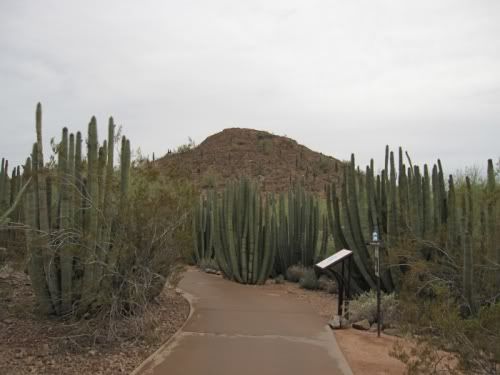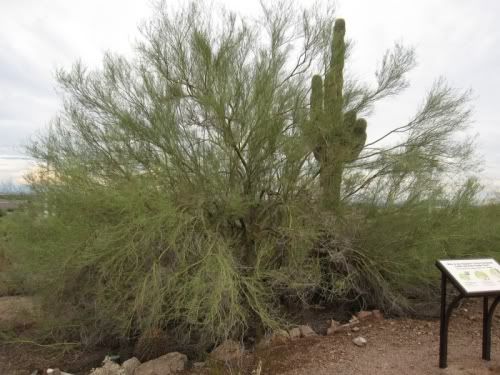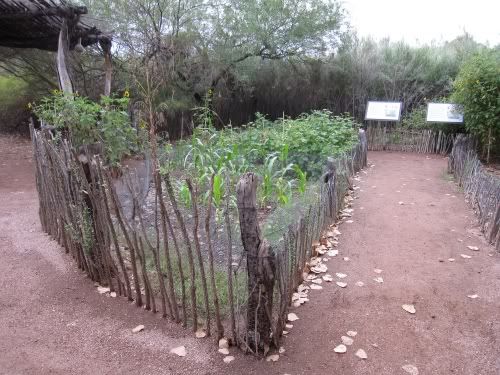Aside from a heavy downpour on the I-10 east of Quartzsite, I did not have much of a problem driving in from California. Today was spent touring the Desert Botanical Garden, located in Phoenix but on the Scottsdale city limits, where I could re-acquaint myself with the unique, beautiful fauna of the Arizona desert.
 Quintessential Arizona sight. A hill full of saguaros in the distance, while the organ pipe cactus grows in the foreground.
Quintessential Arizona sight. A hill full of saguaros in the distance, while the organ pipe cactus grows in the foreground.Saguaros tend to prefer the cooler areas of the Sonoran Desert, notably Tucson and to a lesser extent Phoenix. Organ pipe cactus is more likely to be found in the warmer parts, such as Ajo near the Mexican border, as well as the Mexican states of Sonora, Sinaloa, and Baja California Sur.
It's amazing that even though the Sonoran Desert stretches all the way back to Palm Springs, I could find little more than shrubs in California, but within a few miles of entering Arizona, I could start spotting saguaros and other more interesting plants. They do say that saguaros do grow in very limited numbers on the California side of the Colorado River, but I haven't seen them myself.
 The green tree is named, predictably, Palo Verde. Its green trunks and limbs (the green "stick" that makes up the name) assist with photosynthesis; while most trees use their leaves for photosynthesis, leaves tend to lose a lot of water, a minus in the desert.
The green tree is named, predictably, Palo Verde. Its green trunks and limbs (the green "stick" that makes up the name) assist with photosynthesis; while most trees use their leaves for photosynthesis, leaves tend to lose a lot of water, a minus in the desert.As it turned out, this palo verde sheltered a fragile saguaro seedling as it somehow got dropped under the branches, probably by passing birds. The saguaro has grown well. Unfortunately, the saguaro is now sucking up all the water from the ground using its superior root system, and the palo verde will gradually lose water and eventually die.
 Some of the exhibits are dedicated to human adaptations to living in the harsh desert environment. The exhibits cover four cultures: Akimel O'odham (based around Phoenix), Tohono O'odham (based around Tucson), Apache (based primarily to the north), and Spanish. While the two O'odham cultures were primarily hunter-gatherers, they eventually developed a nice agriculture of their own 2,000 years ago. Akimel O'odham Phoenix even boasted one of the greatest prehistoric irrigation systems. This exhibit is a look at traditional desert agriculture, where a variety of plants could be grown for food, construction materials, clothing, and more. Some plants were native, while others were brought in by the natives' extensive trade relations with other faraway cultures, and/or by the Spanish from their worldwide empire.
Some of the exhibits are dedicated to human adaptations to living in the harsh desert environment. The exhibits cover four cultures: Akimel O'odham (based around Phoenix), Tohono O'odham (based around Tucson), Apache (based primarily to the north), and Spanish. While the two O'odham cultures were primarily hunter-gatherers, they eventually developed a nice agriculture of their own 2,000 years ago. Akimel O'odham Phoenix even boasted one of the greatest prehistoric irrigation systems. This exhibit is a look at traditional desert agriculture, where a variety of plants could be grown for food, construction materials, clothing, and more. Some plants were native, while others were brought in by the natives' extensive trade relations with other faraway cultures, and/or by the Spanish from their worldwide empire.I especially love the fence, made up of ocotillo branches, some of which are still alive and sprouting leaves from the thunderstorm today.
After finishing up this outstanding facility - all sweaty, thanks to the humidity despite the cooler temperature - I proceeded to Scottsdale's posh shopping mall. There is enough wealth out here to justify selling expensive fashion brands, like Ferragamo, Jimmy Choo, or Louis Vuitton, yet I can also buy plenty of moderate-priced goods. I did buy a versatile short-sleeved tunic cardigan from Ann Taylor. Scottsdale is indeed posh - I can drive off in a Ferrari roadster as well. It's kind of difficult for me to think of Arizona as an upper-class place, due to all the low-wage poverty I saw (and experienced) back in my Tucson days, but Scottsdale is where all the haves do live, and yes, John McCain is one of those Arizona haves.
I do have a full day tomorrow, and hope to make the most of it.